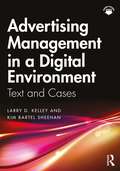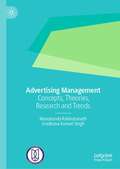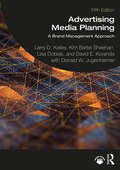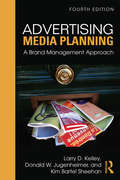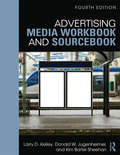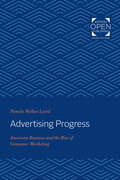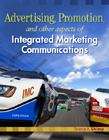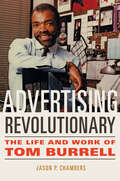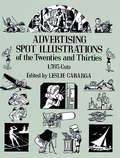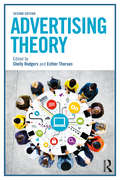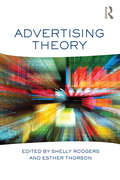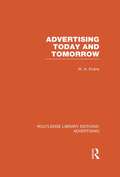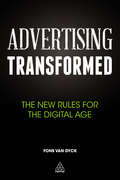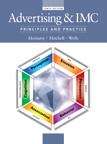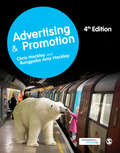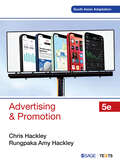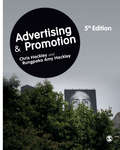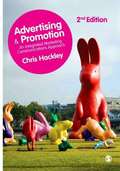- Table View
- List View
Advertising Management in a Digital Environment: Text and Cases
by Larry D. Kelley Kim Bartel SheehanAdvertising Management in a Digital Environment: Text and Cases blends the latest methods for digital communication and an understanding of the global landscape with the best practices of the functional areas of management. Divided into three core sections, the book provides a truly holistic approach to Advertising Management. The first part considers the fundamentals of advertising management, including leadership, ethics and corporate social responsibility, and finance and budgeting. The second part considers human capital management and managing across cultures, whilst the third part discusses strategic planning, decision making and brand strategy. To demonstrate how theory translates to practice in advertising, each chapter is illustrated with real-life case studies from a broad range of sectors, and practical exercises allow case analysis and further learning. This new textbook offers an integrated and global approach to Advertising Management and should be core or recommended reading for undergraduate and postgraduate students of Media Management, Advertising, Marketing Management and Strategy, Communications and Public Relations. The applied approach provided by case study analysis makes it equally suitable for those in executive education and studying for professional qualifications.
Advertising Management: Concepts, Theories, Research and Trends
by Manukonda Rabindranath Aradhana Kumari SinghThis book explores the concept of advertising and the different ways advertising is understood and evaluated. It dives deep into planning, designing, and executing advertising campaigns on different mediums. It discusses the theoretical and research parts of advertising by critically examining how over the years various hierarchical models and theories are developed by advertising experts.It examines various models and theories that explain why and how advertising is successful in persuading customers/target audiences to buy a product or accept an idea for behavioural change. It will help readers to understand the significance of advertising and consumer psychology which has a critical role in purchasing a product or an idea.
Advertising Media Planning: A Brand Management Approach
by Donald W. Jugenheimer Larry D. Kelley Kim Bartel Sheehan Lisa Dobias David E. KorandaAdvertising Media Planning blends the latest methods for digital communication and an understanding of the global landscape with the best practices of the functional areas of media planning. Taking a unique brand communication approach from an agency perspective, the textbook is organized into four key parts, walking the student through the foundations of brand communication, communication planning, the different media channels available, and the process of preparing, presenting, and evaluating a media plan. This 5th edition has been fully updated to include: • An emphasis throughout on digital and global media planning • New chapters on the role of brand communication, media planning and data analytics, paid media, mobile media, influencer marketing, and B2B media • New mini-case studies and innovation-focused call-out boxes throughout, showcasing media examples from Europe, the United States, and Asia • Discussion questions to foster engagement and understanding A highly regarded new edition, this practical and integrated textbook should be core reading for advanced undergraduate and postgraduate students studying Media Planning, Advertising Management, Integrated Marketing Communication, and Brand Management. Instructor resources include: PowerPoint slides, a test bank, and an instructor manual.
Advertising Media Planning: A Brand Management Approach
by Larry Kelley Kim Sheehan Donald JugenheimerThe planning and placement of advertising media is a multibillion dollar business that critically impacts advertising effectiveness. The new edition of this acclaimed and widely adopted text offers practical guidance for those who practice media planning on a daily basis, as well as those who must ultimately approve strategic media decisions. Full of current brand examples, the book is a "must-read" for all who will be involved in the media decision process on both the agency and client side. Its easy-to-read style and logical format make it ideal for classroom adoption, and students will benefit from the down-to-earth approach, and real-world business examples. Several new chapters have been added to the fourth edition, including: International advertising Campaign evaluation The changing role of media planning in agencies, to give the reader a better grounding in the role of media in an advertising and marketing plan today Evaluating media vehicles, filled with up-to-date examples Search engine marketing, and a thorough revision of the chapter on online display advertising to address the increased emphasis on digital media Gaming, and many new examples of the latest digital media with an emphasis on social media, and a new framework for analyzing current and future social media Increased coverage of communication planning Added focus on the importance of media strategy early on in the book Separate chapters for video and audio media (instead of lumping them together in broadcast). This creates a more in-depth discussion of radio in particular An online instructor's manual with PowerPoint slides and sample test questions is available to adopters.
Advertising Media Planning: A Brand Management Approach
by Donald W. Jugenheimer Larry D. Kelly Kim Bartel SheehanUpdated and greatly expanded to reflect the explosive growth of new media, this acclaimed and widely-adopted text offers practical guidance for those involved in media planning on a daily basis as well as those who must ultimately approve strategic media decisions. Its current, real-world business examples and down-to-earth approach will resonate with students as well as media professionals on both the client and agency side.
Advertising Media Workbook and Sourcebook
by Larry Kelley Donald W. Jugenheimer Kim SheehanThis book provides simple explanations of advertising media sources and calculations along with real-world examples of source material from advertising and media companies. Each of the book's 45 concise units opens with a brief text segment, presents sample source materials from actual advertising and media companies, and concludes with hands-on exercises. Compact units cover all key topics including communication planning and media strategies. A media math primer, standard media formulae, media planning checklists, and a glossary of media terms are also included. Designed for practitioners and students, the latest edition includes new exercises with new media formats and digital media and new units devoted to popular social media channels.
Advertising Progress: American Business and the Rise of Consumer Marketing (Studies in Industry and Society #14)
by Pamela Walker LairdSelected by Choice Magazine as an Outstanding Academic TitleOriginally published in 1998. Drawing on both documentary and pictorial evidence, Pamela Walker Laird explores the modernization of American advertising to 1920. She links its rise and transformation to changes that affected American society and business alike, including the rise of professional specialization and the communications revolution that new technologies made possible. Laird finds a fundamental shift in the kinds of people who created advertisements and their relationships to the firms that advertised. Advertising evolved from the work of informing customers (telling people what manufacturers had to sell) to creating consumers (persuading people that they needed to buy). Through this story, Laird shows how and why—in the intense competitions for both markets and cultural authority—the creators of advertisements laid claim to "progress" and used it to legitimate their places in American business and culture.
Advertising Promotion and Other Aspects of Integrated Marketing Communications
by Terence A. ShimpThe eighth edition of Shimp's market-leading Advertising, Promotion, And Other Aspects Of Integrated Marketing Communications fully integrates all aspects of marketing communication. While continuing to focus on the time honored IMC methods, the text reflects new academic literature and practitioner developments in the field.
Advertising Revolutionary: The Life and Work of Tom Burrell
by Jason P. ChambersThe ad exec who revolutionized the image of Black Americans in advertising Over a forty-year career, Chicagoan Tom Burrell changed the face of advertising and revolutionized the industry’s approach to African Americans as human beings and consumers. Jason P. Chambers offers a biography of the groundbreaking creator and entrepreneur that explores Burrell’s role in building brands like McDonald’s and Coca-Cola within a deeply felt vision of folding positive images of Black people into mainstream American life. While detailing Burrell’s successes, Chambers tells a parallel story of what Burrell tried to do that sheds light on the motivations of advertising creators who viewed their work as being about more than just selling. Chambers also highlights how Burrell used his entrepreneurial gifts to build an agency that opened the door for Black artists, copywriters, directors, and other professionals to earn livings, build careers, and become leaders within the industry. Compelling and multidimensional, Advertising Revolutionary combines archival research and interviews with Burrell and his colleagues to provide a long overdue portrait of an advertising industry legend and his times.
Advertising Spot Illustrations of the Twenties and Thirties: 1,593 Cuts (Dover Pictorial Archive)
by Leslie CabargaLively collection of royalty-free spots for commercial artists dramatizes a host of enterprises: business, communications, education, industry, construction, transportation, legal and healthcare services, sports, travel, entertainment, and much more -- all conveniently arranged by category for ease of use.
Advertising Theory (Routledge Communication Series)
by Esther Thorson Shelly RodgersAdvertising Theory provides detailed and current explorations of key theories in the advertising discipline. The volume gives a working knowledge of the primary theoretical approaches of advertising, offering a comprehensive synthesis of the vast literature in the area. Editors Shelly Rodgers and Esther Thorson have developed this volume as a forum in which to compare, contrast, and evaluate advertising theories in a comprehensive and structured presentation. With new chapters on forms of advertising, theories, and concepts, and an emphasis on the role of new technology, this new edition is uniquely positioned to provide detailed overviews of advertising theory. Utilizing McGuire’s persuasion matrix as the structural model for each chapter, the text offers a wider lens through which to view the phenomenon of advertising as it operates within various environments. Within each area of advertising theory—and across advertising contexts—both traditional and non-traditional approaches are addressed, including electronic word-of-mouth advertising, user-generated advertising, and social media advertising contexts. This new edition includes a balance of theory and practice that will help provide a working knowledge of the primary theoretical approaches and will help readers synthesize the vast literature on advertising with the in-depth understanding of practical case studies and examples within every chapter. It also looks at mobile advertising in a broader context beyond the classroom and explores new areas such as native advertising, political advertising, mobile advertising, and digital video gaming.
Advertising Theory: Theory And Research (Lea’s Communication Series)
by Esther Thorson Shelly RodgersAdvertising Theory provides detailed and current explorations of key theories in the advertising discipline. The volume gives a working knowledge of the primary theoretical approaches of advertising, offering a comprehensive synthesis of the vast literature in the area. Editors Shelly Rodgers and Esther Thorson have developed this volume as a forum in which to compare, contrast, and evaluate advertising theories in a comprehensive and structured presentation. Chapters provide concrete examples, case studies, and readings written by leading advertising scholars and educators. Utilizing McGuire's persuasion matrix as the structural model for each chapter, the text offers a wider lens through which to view the phenomenon of advertising as it operates within various environments. Within each area of advertising theory - and across advertising contexts - both traditional and non-traditional approaches are addressed, including electronic word-of-mouth advertising, user-generated advertising, and social media advertising contexts. As a benchmark for the current state of advertising theory, this text will facilitate a deeper understanding for advertising students, and will be required reading for advertising theory coursework.
Advertising Today and Tomorrow: Advertising: Advertising Today And Tomorrow (Routledge Library Editions: Advertising)
by W.A. EvansAdvertising Today and Tomorrow surveys the structure and function of modern advertising (and in particular the modern advertising agency), investigates how appropriate its machinery is for modern business requirements, and suggests how, both for the good of itself and its clients, it can best equip and refine itself for the future. It is of great use to students of business, particularly of marketing, in the colleges, universities and business schools, as well as being of great help to young people seeking to make advertising their career. First published in 1974.
Advertising Transformed
by Fons Van DyckIs advertising dead or alive? Quite simply the 20th century concept of advertising is dead and it will have to reinvent itself in order to survive. This transformation is going on as we speak. Brands that invest in advertising during an economic recession prove to overcome them quicker as times of crisis are typically moments when consumers' mental pecking order is being shaken up. When brand market shares are shifting advertising can be a determining factor for the future of brands. In Advertising: dead or alive, Fons Van Dyck offers strategic answers to questions marketers and managers have about the effectiveness of advertising in the digital age. He discusses the basics of how advertising works in marketing and communications planning today. What is the core target group of advertising? Which strategy works best? Does social media mean the end of advertising? Why is the integration of marketing and communication becoming increasingly important? Are consumers better at advertising? He addresses current advertising practice. What works best: a USP (unique selling proposition) or ESP (emotional selling proposition)? Is the future of advertising global or local? Is 'green' really a sales argument, and if it is, for what type of customer? What is the power of 'retro' in advertising? He explores what academic evidence is available today that demonstrates the added value of marketing and advertising for companies and organisations, even in times of economic recession and concludes by focusing on some of the most important topics of criticism brands and advertising in particular are facing and on how brands are responding. Backed by case studies of Effie Winning brands this book gives the reader concise and accessible insights into the modern form of advertising.
Advertising and Anthropology: Ethnographic Practice and Cultural Perspectives
by Robert J. Morais Timothy de Waal MalefytExamining theory and practice, Advertising and Anthropology is a lively and important contribution to the study of organizational culture, consumption practices, marketing to consumers and the production of creativity in corporate settings. The chapters reflect the authors' extensive lived experienced as professionals in the advertising business and marketing research industry. Essays analyze internal agency and client meetings, competitive pressures and professional relationships and include multiple case studies. The authors describe the structure, function and process of advertising agency work, the mediation and formation of creativity, the centrality of human interactions in agency work, the production of consumer insights and industry ethics. Throughout the book, the authors offer concrete advice for practitioners.Advertising and Anthropology is written by anthropologists for anthropologists as well as students and scholars interested in advertising and related industries such as marketing, marketing research and design.
Advertising and Branding Basics (SAGE Back to Basics)
by SAGE Publications India Pvt. LtdFrom the experts who have witnessed the highs and lows of various brands, Advertising and Branding Basics offers valuable insights on brand building in today’s consumer-centric world. As millennials continue to grapple with bottlenecks such as brand malfunctioning and bad customer reviews, the book provides a holistic review of the industry and why some brands survive the competition and others cease to exist. The book will draw the interest of advertising and branding professionals and new age leaders looking for one-stop advice on the subject. SAGE Back to Basics is a distilled compilation of proven and timeless ideas and best practices for new-age and experienced leaders alike. The hand-picked collection of books—on management, leadership, entrepreneurship, branding and CSR—offer advice from management experts whose knowledge and research has impacted and shaped business and management education. Other books in the series: Timeless Leadership | Leadership Lessons from Dr Pritam Singh | Corporate Social Responsibility in India | Basics of Entrepreneurship | Human Resource Development Insights | Ideate, Brainstorm, Create | Building Professional Competencies | Timeless Management | Soft Skills for Workplace Success
Advertising and IMC: Principles and Practice (Tenth Edition)
by Nancy Mitchell Sandra Moriarty William D. WellsAdvertising tracks the changes in today’s dynamic world of media and marketing communication–as well as the implications of these changes to traditional practice–and presents them to students through an accessible, well-written approach. The Tenth edition highlights the increasing importance of consumers as the driving force in today’s advertising strategies, social media, and the Internet evolution/revolution. It also includes an increased IMC and brand focus.
Advertising and Integrated Brand Promotion
by Richard J. Semenik Angeline Close Scheinbaum Chris T. Allen Thomas Clayton O'GuinnToday's most contemporary ads and exhibits combine with coverage of the latest practices and industry developments, including social media, design thinking, and an emphasis on globalization. The book's focus on real advertising practice is reflected in the book's contents that follows the same process as an advertising agency. Trust ADVERTISING AND INTEGRATED BRAND PROMOTION, 7E to equip you with the tools, knowledge, and practice to get results in advertising and business today.
Advertising and Integrated Brand Promotion
by Angeline Close Scheinbaum Chris T. Allen Thomas Clayton O’Guinn Semenik Richard J.Show students how hard work and careful planning lead to strong advertising with O’Guinn/Allen/Close Scheinbaum/Semenik's ADVERTISING AND INTEGRATED BRAND PROMOTION, 8E. Bring advertising strategy to life with dynamic visuals and examples from today's most contemporary ads. This integrated learning experience focuses on advertising results and business success. A leader for its emphasis on integrated brand promotion and supporting theme of synergy, this edition combines advertising fundamentals with a new unifying conceptual framework and the latest advertising trends. Coverage of social media, design thinking, and globalization exemplifies developments in today's digital society. Students examine concepts in the context of real advertising practice as content follows the process of an actual advertising agency. Comprehensive MindTap integrates discussion of video and other medium.
Advertising and Promotion
by Chris Hackley Dr Rungpaka Amy HackleyUsing a wide range of visual examples and case studies, Advertising and Promotion 4th edition introduces the reader to the key concepts, methods and issues and illustrates these with first-hand examples gathered from leading international advertising agencies and brand campaigns. Told from the perspective of the agency, it gives a fun and creative insider view helping the reader to think beyond the client position and understand what it might be like working within an ad agency. Drawing not only from management and marketing research but also from other disciplines such as cultural/media studies and sociology, the authors offer a rounded and critical perspective on the subject to those looking to understand advertising as social phenomenon in addition to its business function and purpose. The new edition has in-depth coverage of online advertising and the role of social media in advertising including metrics and analytics and includes advertising examples by global brands including Adidas, Benetton, BMW, Dove and DeBeers. “Snapshots” bring in aspects of cross-cultural advertising such as Barbie in China. The book is complemented by a companion website featuring a range of tools and resources for lecturers and students, including PowerPoint slides, an instructor’s manual, SAGE journal articles, links to further online resources and author Videos. The textbook is also supported by an author-written blog which keeps readers updated on interesting, topical examples relating to advertising and promotion from current affairs and popular culture: www.hackleyadvertisingandpromotion.blogspot.com. Suitable for Advertising, Marketing and Communications modules at undergraduate or postgraduate level.
Advertising and Promotion
by Chris Hackley Rungpaka Amy HackleyNow in its fifth edition, this popular textbook continues to provide students with a comprehensive insight into the world of advertising and promotional communications. Unique in its approach, the authors situate the key concepts of marketing communications from the perspective of advertising agencies and provide insight into what a career within an ad agency might be like. Their critical approach grounded in up-to-date research allows the reader to develop an interdisciplinary understanding of marketing and advertising, including business, socio-cultural, media studies and consumer culture theory perspectives. Along with striking full colour visual advertisements and illustrations, new examples and case studies, this fifth edition has been fully updated to include: Two brand new chapters on Social Media Advertising and Digital Advertising Commentary on how the COVID-19 pandemic has and will impact advertising The evolving role of advertising agencies in the post digital era Emerging forms of advertising and promotion, including the role of influencers
Advertising and Promotion
by Chris Hackley Dr Rungpaka Amy HackleyUsing a wide range of visual examples and case studies, Advertising and Promotion 4th edition introduces the reader to the key concepts, methods and issues and illustrates these with first-hand examples gathered from leading international advertising agencies and brand campaigns. Told from the perspective of the agency, it gives a fun and creative insider view helping the reader to think beyond the client position and understand what it might be like working within an ad agency. Drawing not only from management and marketing research but also from other disciplines such as cultural/media studies and sociology, the authors offer a rounded and critical perspective on the subject to those looking to understand advertising as social phenomenon in addition to its business function and purpose. The new edition has in-depth coverage of online advertising and the role of social media in advertising including metrics and analytics and includes advertising examples by global brands including Adidas, Benetton, BMW, Dove and DeBeers. “Snapshots” bring in aspects of cross-cultural advertising such as Barbie in China. The book is complemented by a companion website featuring a range of tools and resources for lecturers and students, including PowerPoint slides, an instructor’s manual, SAGE journal articles, links to further online resources and author Videos. The textbook is also supported by an author-written blog which keeps readers updated on interesting, topical examples relating to advertising and promotion from current affairs and popular culture: www.hackleyadvertisingandpromotion.blogspot.com. Suitable for Advertising, Marketing and Communications modules at undergraduate or postgraduate level.
Advertising and Promotion
by Chris Hackley Rungpaka Amy HackleyNow in its fifth edition, this popular textbook continues to provide a comprehensive insight into the world of advertising and promotional communications. Unique in its approach, the authors situate the key concepts of marketing communications from the perspective of advertising agencies and provide insight into what a career within an ad agency might be like. Their critical approach grounded in up-to-date research allows the reader to develop an interdisciplinary understanding of marketing and advertising, including business, socio-cultural, media studies and consumer culture theory perspectives. Along with striking full colour visual advertisements and illustrations, new examples and case studies, this fifth edition has been fully updated to include: Two brand new chapters on Social Media Advertising and Digital Advertising Commentary on how the COVID-19 pandemic has and will impact advertising The evolving role of advertising agencies in the post digital era Emerging forms of advertising and promotion, including the role of influencers
Advertising and Promotion
by Chris Hackley Rungpaka Amy HackleyNow in its fifth edition, this popular textbook continues to provide a comprehensive insight into the world of advertising and promotional communications. Unique in its approach, the authors situate the key concepts of marketing communications from the perspective of advertising agencies and provide insight into what a career within an ad agency might be like. Their critical approach grounded in up-to-date research allows the reader to develop an interdisciplinary understanding of marketing and advertising, including business, socio-cultural, media studies and consumer culture theory perspectives. Along with striking full colour visual advertisements and illustrations, new examples and case studies, this fifth edition has been fully updated to include: Two brand new chapters on Social Media Advertising and Digital Advertising Commentary on how the COVID-19 pandemic has and will impact advertising The evolving role of advertising agencies in the post digital era Emerging forms of advertising and promotion, including the role of influencers
Advertising and Promotion
by Dr Chris Hackley'Bridges the academic gap between textbook and leading edge marketing thinking. It has been substantially revised and is particularly strong on electronic media and their current marketing usage' - Ros Masterson, De Montfort University, Leicester, UK 'Lucid, insightful, an inspiration for even more creative communications and a treat for the mind. A must read for all wanting to better understand advertising and promotions' - Leslie de Chernatony Professor of Brand Marketing, Università della Svizzera Italiana, Lugano, Switzerland and Aston Business School, UK The eagerly-awaited Second Edition of Advertising and Promotion continues to provide a highly readable and authoritative introduction to the key concepts and issues for the study of advertising and promotional communication in a global context. NEW to this edition: - A stronger focus on integrated marketing communications and the promotional mix, including PR and personal selling. - Expanded coverage of contemporary topics, including: integrating e-marketing, Web 2.0, mobile advertising, sponsorship, branding, direct marketing, ethics, and social responsibility and regulation. - A focus on the implications for advertising of the continuing changes in the media infrastructure and the new media funding models emerging as a result. - A companion website including a full instructors' manual for lecturers, including PowerPoint slides and extra case studies, and access to full-text journal articles for students (www.sagepub.co.uk/hackley) Packed with case studies and first-hand examples gathered from leading international advertising agencies, Chris Hackley succeeds in providing a lively and stimulating guide to the rapidly evolving advertising environment.
